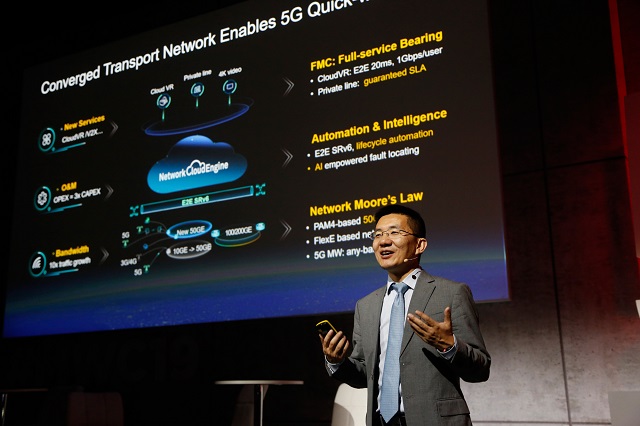Telecom equipment supplier Huawei has revealed the benefits of the 5G-ready converged transport network solution. Huawei claims that it has already won over 40 commercial 5G transport contracts.
 Huawei is the global mobile transport market leader for 7 consecutive years. It has helped global operators build over 40 5G transport networks.
Huawei is the global mobile transport market leader for 7 consecutive years. It has helped global operators build over 40 5G transport networks.
GSMA predicts that by 2025, there will be 1.3 billion 5G users and 1.36 billion 5G mobile devices around the world, with 40 percent 5G network coverage.
Telecom operators are investing transport networks in advance in order to build 5G networks. Telecom engineers believe that 5G networks bring 10x higher network bandwidth, 10x more complexity in network operations & maintenance (O&M), and 100x more connections.
Operators must consider three major issues: affordable bandwidth upgrade costs, 4G and 5G converged transport, and end-to-end automated O&M, said Jeffrey Gao, president of Huawei Router & Carrier Ethernet Product Line.
The 5G-ready converged transport network solution was built upon the industry’s first 50GE router and 5G microwave solution. This results in 10 Gbps to sites and 30 percent lower total cost of operation (TCO).
The router – in fiber access scenarios — supports two-way single-fiber transmission, reducing cost per bit by 30 percent and fiber resources required by 50 percent.
Huawei’s 5G microwave solution – in scenarios without fiber access — can deliver 10 Gbps bandwidth access over any frequency band. It offers flexible channel expansion capabilities, so that only one site visit is needed for service provisioning, reducing operator TCO by 30 percent.
The 5G-ready converged transport network solution uses SR and SRv6 solution, enabling smooth evolution from MPLS to SR and SRv6 protocols, with no interference between 4G and 5G services.
Huawei’s 5G transport solution supports both MPLS and SR protocols and operators can use the SR and SRv6 protocols for deploying end-to-end 5G services while simultaneously using the MPLS protocol for 4G services.
The SR and SRv6 solution — built on the network processor (NP) programmable architecture — supports smooth evolution from MPLS to SR and then to SRv6 without any changes to the hardware.
